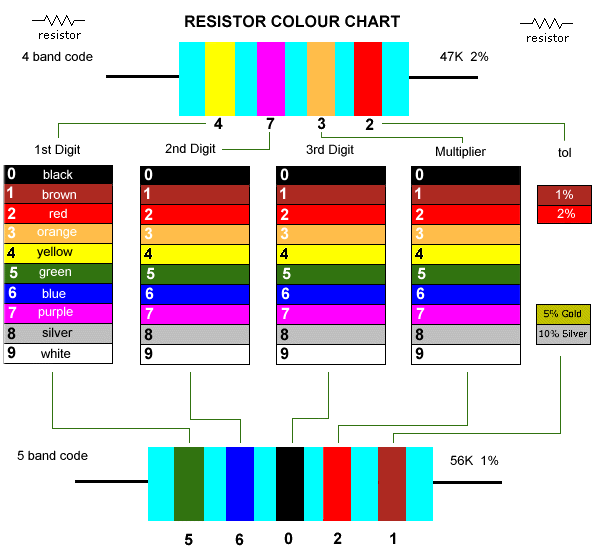Resistor colours by numbers
| BLACK |
BROWN |
RED |
ORANGE |
YELLOW |
GREEN |
BLUE |
PURPLE |
SILVER |
WHITE |
| 0 |
1
|
2
|
3
|
4
|
5
|
6
|
7
|
8
|
9
|
Resistor colour code chart
I have accomodated two current colour banding of resistances - four band and five band resistance colour code. It should be pretty self explanatory I hope.

The five band resistor color code is more likely to be associated with the more precision 1% and 2% types. Your "garden variety" 5% general purpose types will be four band resistance codes.
Resistors come in a range of values but the two most common are the E12 and E24 series. The E12 series comes in twelve vaues for every decade. The E24 series comes in twent four vales per decade.
E12 series - 10, 12, 15, 18, 22, 27, 33, 39, 47, 56, 68, 82
E24 series - 10, 11, 12, 13, 15, 16, 18, 20, 22, 24, 27, 30, 33, 36, 39, 43, 47, 51, 56, 62, 68, 72, 82, 91
You will notice with the E12 values that each succeeding value falls within the plus / minus 10% of the previous values. This stems from the real old days when resistances were stated as within 20% tolerance (accuracy). Later values of plus / minus 5% tolerance led to the E24 range of resistance. Quite common today are 2% tolerance metal films types but for general purpose use we tend to stick to E12 values of resistance in either 1%, 2% or 5% tolerance.
Link to this page
NEW! - How to link directly to this page
Want to create a page link to me from your site? It couldn't be easier. No HTML knowledge required; even the technophobes can do it. All you need to do is copy and paste, the following code. All links are greatly appreciated; I sincerely thank you for your support.
Copy and paste the following code for a text link:
<a href="http://www.electronics-tutorials.com/basics/resistor-color-code.htm" target="_top">visit Ian Purdie VK2TIP's "Resistor Color Code" Page</a>
and it should appear like this:
visit Ian Purdie VK2TIP's "Resistor Color Code" Page

This site is hosted at WebWizards.Net for better value.
CARE TO BE A PRACTICAL SUPPORTER OF THIS SITE?
As you would imagine maintaining this site costs me considerable sums of money in many, many ways. If you believe this site is a valuable and FREE educational resource and, YOU want to keep it that way, then here's how YOU can demonstrate your very practical support for this site..
Thanks to these fine folks making voluntary donations, ensuring this site and our Newsletter remains FREE. Could YOU be listed here for your small contribution in return for your FREE education?. Our grateful thanks.


Please send me your valuable comments and suggestions! Tell your friends, tell a news group, tell your favourite magazine, heck tell the world!
Absolutely essential to keeping abreast of new and updated electronics tutorials is our comments or subscribe to our highly regarded FREE monthly newsletter form. Unsubscribe any time you like. You can view immediate past issues here to see if it is to your liking.

YOU ARE HERE: HOME > BASICS > RESISTOR COLOR CODE
the author Ian C. Purdie, VK2TIP of www.electronics-tutorials.com asserts the moral right to
be identified as the author of this web site and all contents herein. Copyright © 2000, all rights reserved. See copying and links.
These electronic tutorials are provided for individual private use and the author assumes no liability whatsoever for the application, use, misuse, of any of these projects or electronics tutorials that may result in the direct or indirect damage or loss that comes from these projects or tutorials. All materials are provided for free private and public use.
Commercial use prohibited without prior written permission from www.electronics-tutorials.com.
Copyright © 2000, all rights reserved. URL - www.electronics-tutorials.com/basics/resistor-color-code.htm
Updated 15th May, 2000
webmaster@electronics-tutorials.com


